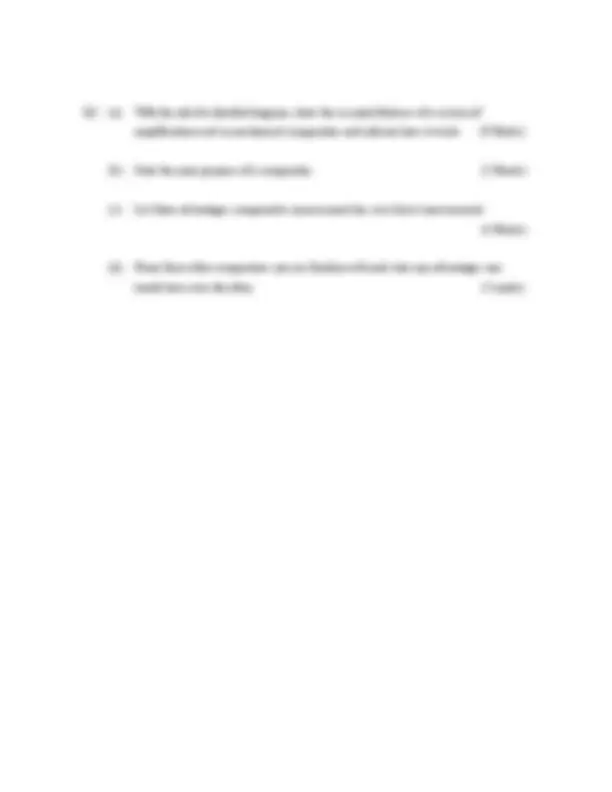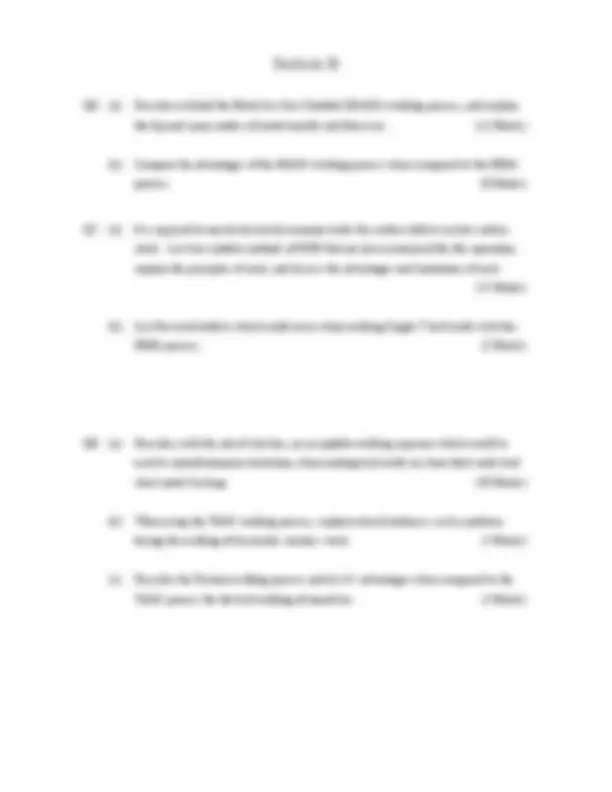




Study with the several resources on Docsity

Earn points by helping other students or get them with a premium plan


Prepare for your exams
Study with the several resources on Docsity

Earn points to download
Earn points by helping other students or get them with a premium plan
Community
Ask the community for help and clear up your study doubts
Discover the best universities in your country according to Docsity users
Free resources
Download our free guides on studying techniques, anxiety management strategies, and thesis advice from Docsity tutors
A past exam paper for the manufacturing technology module of the bachelor of engineering in mechanical engineering at cork institute of technology. The exam covers topics such as setting up and operating a cnc lathe, surface grinding, and welding. It includes five questions, three from section a and two from section b, with a total of 36 marks. Students are required to answer all questions and separate their answers for each section.
Typology: Exams
1 / 4

This page cannot be seen from the preview
Don't miss anything!



Answer Five questions. Three from Section A Examiner: Mr. R. Kennedy and TWO from Section B Mr. J. Burns All questions carry equal marks Dr. P. Delassus User separate answer books for Sections A and B. Mr A. Bateman
Q1. (a) While setting up the CNC lathe, describe the following using block diagrams: (i) How to approach the reference points (ii) How to call up a programme already installed in the memory of the machine. (4 Marks)
(b) Assuming you already have a programme installed in the memory of the CNC lathe list the sequence of checks you would make to ensure the safe automatic machining of the work. (6 Marks)
(c) Describe the procedure you would adopt to identify any station number on the turret of a CNC lathe. (2 Marks)
(d) Assuming you are installing a carbide-tipped cutter into one of the stations on the CNC lathe. List in detail the sequence of operations in order to establish tool data and input it into the memory of the machine. (8 Marks)
Q2. (a) In order to maintain accuracy, the surface grinding machine must be extremely rigid. Explain how this is achieved. (4 Marks)
(b) Precision grinding machines fall into four categories. What are they? (4 Marks)
(c) In order to produce cylindrical and flat work surfaces, three alignments are necessary. Please list them. (6 Marks)
(d) With the aid of a neat sectional diagram, describe the operation of a permanent magnetic chuck and state where it might be used. (6 Marks)
Q3. (a) State some of the factors which affect machining. (4 Marks)
(b) With the aid of labelled diagrams, differentiate between peripheral and face grinding. (3 Marks) (c) Suggest three important reasons for using a grinding process in the machine-shop. (3 Marks) (d) Write a note on jigs and fixtures and indicate in detail what they are used for. Use a neat labelled diagram to describe a jig. (10 Marks)
Q4. (a) Calculate the in feed on a top slide when cutting a thread of 2.5mm pitch I.S.O. form using the half angle method. (3 Marks)
(b) Calculate the tailstock offset to turn a taper of 2.5 in 550 on a mandrel 200mm long. (3 Marks)
(c) List the advantages of using a taper turning attachment over offsetting the tailstock of the lathe. (4 Marks)
(d) With the aid of a neat detailed diagram describe the taper turning attachment. (10 marks)
Q6. (a) Describe in detail the Metal Arc Gas Shielded (MAGS) welding process, and explain the dip and spray modes of metal transfer and their uses. (12 Marks)
(b) Compare the advantages of the MAGS welding process when compared to the MMA process. (8 Marks)
Q7. (a) It is required to non destructively examine welds for surface defects on low carbon steels. List two suitable methods of NDE that are also economical for this operation, explain the principles of each, and discuss the advantages and limitations of each. (15 Marks)
(b) List five weld defects which could occur when welding Single V butt welds with the MMA process. (5 Marks)
Q8. (a) Describe, with the aid of sketches, an acceptable welding sequence which could be used to control/minimise distortion, when making butt welds on 4mm thick mild steel sheet metal 4m long. (10 Marks)
(b) When using the TAGS welding process, explain why distortion is such a problem during the welding of Austenitic stainless steels. (5 Marks)
(c) Describe the Friction welding process and list it’s advantages when compared to the TAGS process for the butt welding of round bar. (5 Marks)